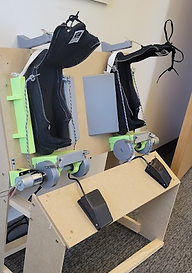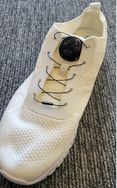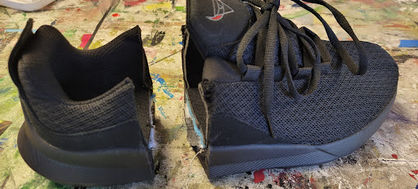Overview
Context
This project was a semester-long group project completed with two other human factors master's students and one mechanical engineering master's student. This project was the main assignment in our course, Assistive Design.
Background
Our client was a 27-year -old male with athetoid cerebral palsy, a movement disorder characterized by limited mobility and abnormal and involuntary movement. Because of this disorder, our client relies on his parents and PCA to assist him in daily tasks, including putting his shoes on. Our client has a passion for shoes and aspires to be more independent in his daily life, so he would love some way to put his shoes on by himself.
Problem Statement
Our solution should allow our client to put his shoes on with minimal to no assistance because he strives for more independence in his daily tasks.
Process
Our process involved reviewing a prior group's materials, creating a list of user needs which we updated over the course of the semester, conducting market research on existing assistive shoe devices, several group meetings for design brainstorming and prototyping, and several in-person meetings with our client to ask questions, test prototypes, and get as much feedback as possible
Initial List of User Needs
(Based on work conducted by prior group)
-
Can be used with minimal assistance from other people
-
Device must work with client’s current shoes (should not have to buy new shoes)
-
Shoe style must be preserved
-
Can be used with different types of shoes (mainly sneakers and boat shoes)
-
Must work with size 8 shoes
-
Must secure shoes tightly
-
Takes under 5 minutes to use
-
Can be used in his kitchen
-
Safe
Market Research
Market research revealed a lot of assistive shoe devices that helped with less extreme disabilities or physical limitations (e.g., shoehorn-like devices, elastic laces). These devices still required certain levels of dexterity that would be challenging for our client to achieve. We realized that any solution we created was going to need to be a lot more complex. There were a few solutions from our initial market research that revealed some potentially promising directions like the Nike FlyEase and Nike Adapt, but these solutions would involve creating new shoes or modifying existing shoes (thereby not in accordance with our user needs).
Low-Fidelity Prototypes
For first in person meeting with our client, we wanted to present a wide variety of low-fi prototypes. Even though we were aware that our client wanted something that worked with his current shoes, we wanted to keep an open mind about the potential solutions we could come up with even if they didn’t necessarily meet that user need. In this first meeting, we learned that, although an ideal solution for our client would be one that works with his existing shoes, he prioritizes gaining independence above all else, even if that means having to wear shoes that are augmented. Through this realization and some feedback from our client on our various low-fi prototypes, we determined that augmenting shoes by adding a zipper on the side to increase the size of the shoe opening would be the best path forward. We also adjusted our user needs list to reflect our new understanding of the desires of our client.
Revised User Needs:
-
Can be used with minimal assistance from other people
-
Must work with size 8 shoes
-
Must secure shoes tightly
-
Takes under 5 minutes to use
-
Can be used in his kitchen
-
Safe
-
Any augmentations to shoes should not be very noticeable
From "needs" to "wants":
-
Device must work with client’s current shoes (should not have to buy new shoes)
-
Shoe style must be preserved
-
Can be used with different types of shoes (mainly sneakers and boat shoes)
Now that we have decided to go with a zipper design, the question is:
How can we allow our client to zip the shoes up on his own?
Mid-Fidelity Prototype + Testing

Description: A mobile platform connected to a stationary base. When the platform is pushed forward, a string attached to a magnet pulls the zipper tight. When the shoe is fully zipped, the magnet detaches
Testing insights:
Observations
The shoe opening is still not big enough. Our client struggles to place feet in shoe.
Design Changes
Add a second zipper to increase size of shoe opening.
Attempts to push platform forward typically result in erratic movement, causing foot to leave shoe.
Automate zippers so minimal action is required by client.
Final Prototype
Final Prototype V1
(Conceptual)
Final Prototype V2
(Functional)

.png)
Note: V1 features a leg stabilizer behind the shoe which was deemed unsuccessful based on feedback from user
Description: Shoes augmented with zippers are fixed to an inclined platform with bands and plastic barriers. The top of the shoes are held open by a clip at the top of the platform while the user places their feet into the shoes. Once the user's feet are in the shoes, the user pushes a button and motorized coils behind the shoes pull the zippers tight via strings attached to magnets. When the shoes are fully zipped, the magnets detach.
Final Prototype Testing Results

We divided our testing criteria into three stages: inserting foot into shoe, tightening shoe, and detaching shoe from device. We tested our device based on the criterion of effectiveness. That is: was our client able to complete each stage successfully at least once? We also considered user satisfaction and gauged this metric through follow-up questions after the testing. We were less concerned with efficiency given that our prototype was still relatively early in development and we knew it would not perform well in this regard.
Our final prototype was successful in the first and third stages but not successful with the tightening. Our client still struggles to place his feet into the shoes without his toes curled, causing the zippers to get caught and the magnets to detach before the shoes were fully zipped.
Although our prototype was not completely successful, user satisfaction was high, as our client was pleased with the general concept and its potential.
Impact
While our final prototype was not entirely successful, we believe this concept has the potential to succeed upon further development. We have provided a helpful framework for the next groups who work to solve this problem. Additionally, while we weren’t able to provide full independence to our client in this task, he was still very satisfied with the progress we made over the course of the semester and was very excited about the potential of the concept we designed.
.png)














